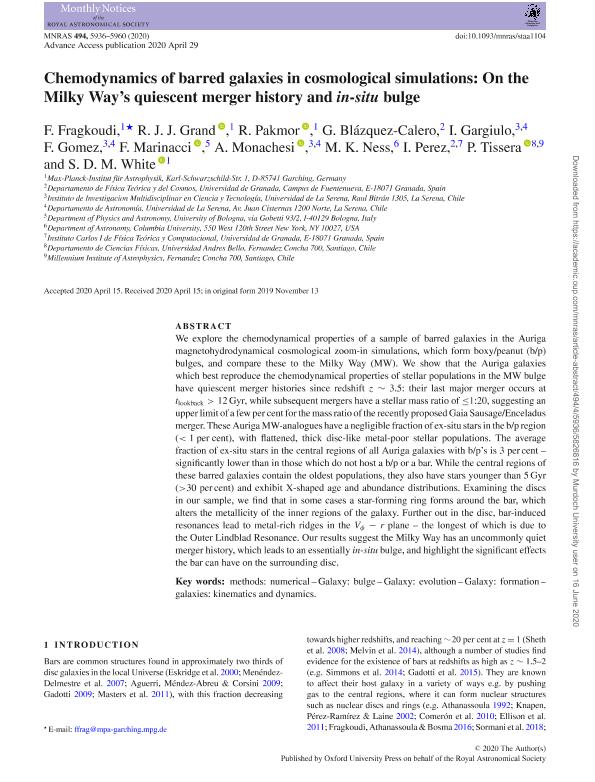Mostrar el registro sencillo del ítem
dc.contributor.author
Fragkoudi, F
dc.contributor.author
Grand, R. J. J.
dc.contributor.author
Pakmor, R
dc.contributor.author
Blázquez Calero, G
dc.contributor.author
Gargiulo, Ignacio Daniel

dc.contributor.author
Gomez, F.
dc.contributor.author
Marinacci, F.
dc.contributor.author
Monachesi, A.
dc.contributor.author
Ness, M. K.
dc.contributor.author
Perez, I.
dc.contributor.author
Tissera, Patricia Beatriz

dc.contributor.author
White, S. D. M.
dc.date.available
2021-10-18T17:30:40Z
dc.date.issued
2020-06
dc.identifier.citation
Fragkoudi, F; Grand, R. J. J.; Pakmor, R; Blázquez Calero, G; Gargiulo, Ignacio Daniel; et al.; Chemodynamics of barred galaxies in cosmological simulations: On the Milky Way’s quiescent merger history and in-situ bulge; Wiley Blackwell Publishing, Inc; Monthly Notices of the Royal Astronomical Society; 494; 4; 6-2020; 5936-5960
dc.identifier.issn
0035-8711
dc.identifier.uri
http://hdl.handle.net/11336/144131
dc.description.abstract
We explore the chemodynamical properties of a sample of barred galaxies in the Auriga magnetohydrodynamical cosmological zoom-in simulations, which form boxy/peanut (b/p) bulges, and compare these to the Milky Way (MW). We show that the Auriga galaxies which best reproduce the chemodynamical properties of stellar populations in the MW bulge have quiescent merger histories since redshift z ∼ 3.5: their last major merger occurs at tlookback > 12 Gyr, while subsequent mergers have a stellar mass ratio of ≤1:20, suggesting an upper limit of a few per cent for the mass ratio of the recently proposed Gaia Sausage/Enceladus merger. These Auriga MW-analogues have a negligible fraction of ex-situ stars in the b/p region (< 1 per cent), with flattened, thick disc-like metal-poor stellar populations. The average fraction of ex-situ stars in the central regions of all Auriga galaxies with b/p’s is 3 per cent – significantly lower than in those which do not host a b/p or a bar. While the central regions of these barred galaxies contain the oldest populations, they also have stars younger than 5 Gyr (>30 per cent) and exhibit X-shaped age and abundance distributions. Examining the discs in our sample, we find that in some cases a star-forming ring forms around the bar, which alters the metallicity of the inner regions of the galaxy. Further out in the disc, bar-induced resonances lead to metal-rich ridges in the Vφ − r plane – the longest of which is due to the Outer Lindblad Resonance. Our results suggest the Milky Way has an uncommonly quiet merger history, which leads to an essentially
dc.format
application/pdf
dc.language.iso
eng
dc.publisher
Wiley Blackwell Publishing, Inc

dc.rights
info:eu-repo/semantics/openAccess
dc.rights.uri
https://creativecommons.org/licenses/by-nc-sa/2.5/ar/
dc.subject
Galaxy: bulge
dc.subject
Galaxy: formation
dc.subject
Galaxy: evolution
dc.subject
galaxies: kinematics and dynamics
dc.subject.classification
Astronomía

dc.subject.classification
Ciencias Físicas

dc.subject.classification
CIENCIAS NATURALES Y EXACTAS

dc.title
Chemodynamics of barred galaxies in cosmological simulations: On the Milky Way’s quiescent merger history and in-situ bulge
dc.type
info:eu-repo/semantics/article
dc.type
info:ar-repo/semantics/artículo
dc.type
info:eu-repo/semantics/publishedVersion
dc.date.updated
2021-08-17T15:53:36Z
dc.journal.volume
494
dc.journal.number
4
dc.journal.pagination
5936-5960
dc.journal.pais
Reino Unido

dc.description.fil
Fil: Fragkoudi, F. Institut Max Planck Fur Astrophysics; Alemania
dc.description.fil
Fil: Grand, R. J. J.. Institut Max Planck Fur Astrophysics; Alemania
dc.description.fil
Fil: Pakmor, R. Institut Max Planck Fur Astrophysics; Alemania
dc.description.fil
Fil: Blázquez Calero, G. Departamento de Fisica Teorica y del Cosmos; España
dc.description.fil
Fil: Gargiulo, Ignacio Daniel. Universidad de La Serena; Chile
dc.description.fil
Fil: Gomez, F.. Universidad de La Serena; Chile
dc.description.fil
Fil: Marinacci, F.. University Of Bologna; Italia
dc.description.fil
Fil: Monachesi, A.. Universidad de La Serena; Chile
dc.description.fil
Fil: Ness, M. K.. Columbia University; Estados Unidos
dc.description.fil
Fil: Perez, I.. Departamento de Fisica Teorica y del Cosmos; España
dc.description.fil
Fil: Tissera, Patricia Beatriz. Departamento de Ciencias Fisicas, Universidad Andres Be; Chile
dc.description.fil
Fil: White, S. D. M.. Institut Max Planck Fur Astrophysics; Alemania
dc.journal.title
Monthly Notices of the Royal Astronomical Society

dc.relation.alternativeid
info:eu-repo/semantics/altIdentifier/url/https://academic.oup.com/mnras/article/494/4/5936/5826816
dc.relation.alternativeid
info:eu-repo/semantics/altIdentifier/doi/http://dx.doi.org/10.1093/mnras/staa1104
Archivos asociados
